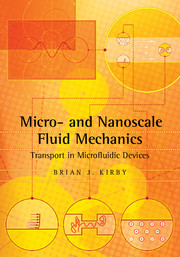Book contents
- Frontmatter
- Contents
- Preface
- Nomenclature
- Introduction
- 1 Kinematics, Conservation Equations, and Boundary Conditions for Incompressible Flow
- 2 Unidirectional Flow
- 3 Hydraulic Circuit Analysis
- 4 Passive Scalar Transport: Dispersion, Patterning, and Mixing
- 5 Electrostatics and Electrodynamics
- 6 Electroosmosis
- 7 Potential Fluid Flow
- 8 Stokes Flow
- 9 The Diffuse Structure of the Electrical Double Layer
- 10 Zeta Potential in Microchannels
- 11 Species and Charge Transport
- 12 Microchip Chemical Separations
- 13 Particle Electrophoresis
- 14 DNA Transport and Analysis
- 15 Nanofluidics: Fluid and Current Flow in Molecular-Scale and Thick-EDL Systems
- 16 AC Electrokinetics and the Dynamics of Diffuse Charge
- 17 Particle and Droplet Actuation: Dielectrophoresis, Magnetophoresis, and Digital Microfluidics
- APPENDIX A Units and Fundamental Constants
- APPENDIX B Properties of Electrolyte Solutions
- APPENDIX C Coordinate Systems and Vector Calculus
- APPENDIX D Governing Equation Reference
- APPENDIX E Nondimensionalization and Characteristic Parameters
- APPENDIX F Multipolar Solutions to the Laplace and Stokes Equations
- APPENDIX G Complex Functions
- APPENDIX H Interaction Potentials: Atomistic Modeling of Solvents and Solutes
- Bibliography
- Index
5 - Electrostatics and Electrodynamics
Published online by Cambridge University Press: 05 June 2012
- Frontmatter
- Contents
- Preface
- Nomenclature
- Introduction
- 1 Kinematics, Conservation Equations, and Boundary Conditions for Incompressible Flow
- 2 Unidirectional Flow
- 3 Hydraulic Circuit Analysis
- 4 Passive Scalar Transport: Dispersion, Patterning, and Mixing
- 5 Electrostatics and Electrodynamics
- 6 Electroosmosis
- 7 Potential Fluid Flow
- 8 Stokes Flow
- 9 The Diffuse Structure of the Electrical Double Layer
- 10 Zeta Potential in Microchannels
- 11 Species and Charge Transport
- 12 Microchip Chemical Separations
- 13 Particle Electrophoresis
- 14 DNA Transport and Analysis
- 15 Nanofluidics: Fluid and Current Flow in Molecular-Scale and Thick-EDL Systems
- 16 AC Electrokinetics and the Dynamics of Diffuse Charge
- 17 Particle and Droplet Actuation: Dielectrophoresis, Magnetophoresis, and Digital Microfluidics
- APPENDIX A Units and Fundamental Constants
- APPENDIX B Properties of Electrolyte Solutions
- APPENDIX C Coordinate Systems and Vector Calculus
- APPENDIX D Governing Equation Reference
- APPENDIX E Nondimensionalization and Characteristic Parameters
- APPENDIX F Multipolar Solutions to the Laplace and Stokes Equations
- APPENDIX G Complex Functions
- APPENDIX H Interaction Potentials: Atomistic Modeling of Solvents and Solutes
- Bibliography
- Index
Summary
This text is primarily concerned with the behavior of fluids in micro- and nanofabricated systems; however, the ubiquity of diffuse charge in solution and the routine use of applied electric fields requires that the electrodynamic equations be solved simultaneously with the fluid equations, leading to a body force term that modifies the fluid velocity fields. This chapter summarizes the fundamental equations of electrostatics and electrodynamics with specific focus on aqueous solutions with boundary conditions typical of microfluidic devices. A description of electrical circuits, which describe the electrostatics and electrodynamics of discretized elements, is also presented.
ELECTROSTATICS IN MATTER
Electrostatics describes the effects caused by stationary source charges or static electric fields on other charges, termed test charges. The electrostatic limit applies when all charges are stationary and the current is zero. The equations and boundary conditions of electrostatics are all derived from Coulomb's law.
We study charges in matter, usually in an aqueous solution (we also call this an electrolyte solution) or in a metal conductor. In matter, it becomes unwieldy to keep track of all of the electrostatic interactions. To simplify things, we distinguish between free charge and bound charge and keep detailed track of only the free charge. Free charge implies a charge that is mobile over distances that are large relative to atomic length scales. Free charge typically comes from electrons (in a metal) or ions (in an aqueous solution).
- Type
- Chapter
- Information
- Micro- and Nanoscale Fluid MechanicsTransport in Microfluidic Devices, pp. 97 - 130Publisher: Cambridge University PressPrint publication year: 2010



